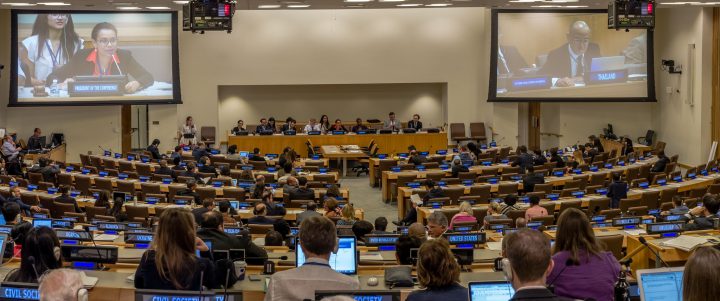- Final draft treaty that will ban nuclear weapons released by 130+ negotiating countries
- Adoption of treaty expected Friday, July 7
- Treaty would ban nuclear weapons research, possession, use, deterrence, and assistance in any of these prohibited acts
- Treaty commits governments to adopt laws criminalizing nuclear weapons work
Late on Monday, July 3, in New York Ambassador Elayne Whyte Gomez, President of the United Nations Conference to Negotiate a Legally Binding Instrument to Prohibit Nuclear Weapons, released the final draft text of the “Treaty on the Prohibition of Nuclear Weapons.”
With at least 130 countries participating in negotiations, the Treaty is widely expected to be adopted Friday with minimal if any changes.
Negotiations on the treaty began in late March (“US, Allies, Stage Protest Outside UN General Assembly Hall as Nations Gather in Unprecedented Meeting to Ban Nuclear Weapons,” Mar 27, 2017) pursuant to a General Assembly mandate passed last December (“In Historic Vote, UN General Assembly Mandates 2017 Negotiations to Ban Research, Development, Testing, Stockpiling, Use of Nuclear Weapons,” Dec 23, 2016).
Earlier, elements of the treaty were discussed at length by a special Open-Ended Working Group meeting in Geneva (“UN Disarmament Working Group Calls for 2017 Negotiations to Ban Nuclear Weapons,” Aug 19, 2016). These meetings were the result of years of efforts by civil society groups and leading states.
The draft Treaty prohibits signatory states from conducting or allowing a wide range of nuclear weapons activities, including: developing, testing, producing, manufacturing, and deploying; transferring to others or receiving from others; using or threatening to use nuclear weapons; allowing any stationing or deployment of nuclear weapons on national territories; and assisting, encouraging, or inducing anyone in any of these prohibited acts.
The draft Treaty requires each signatory state to develop “legal, administrative and other measures, including the imposition of penal sanctions, to prevent and suppress” any of these prohibited activities.
If adopted on Friday, the Treaty will be opened for signature on September 19, 2017, the first day of regular debate in the fall session of the General Assembly, when heads of state and other dignitaries will be present.
The Treaty, if adopted by at least a two-thirds majority vote of states Friday morning, can be amended at regular or extraordinary meetings of signatory states by the same two-thirds majority.
The Treaty will enter in force 90 days after at least 50 countries have ratified it.
The draft Treaty has a lengthy Preamble reflecting some of the moral, legal, and scientific concerns underlying these negotiations and this Treaty. The negotiating countries are (for example):
Basing themselves on the principles and rules of international humanitarian law, in particular the principle that the right of parties to an armed conflict to choose methods or means of warfare is not unlimited, the rule of distinction, the prohibition against indiscriminate attacks, the rules on proportionality and precautions in attack, the prohibition on the use of weapons of a nature to cause superfluous injury or unnecessary suffering, and the rules for the protection of the natural environment,
Considering that any use of nuclear weapons would be contrary to the rules of international law applicable in armed conflict, in particular the principles and rules of international humanitarian law,
Reaffirming that any use of nuclear weapons would also be abhorrent to the principles of humanity and the dictates of public conscience,
…
Concerned by the slow pace of nuclear disarmament, the continued reliance on nuclear weapons in military and security concepts, doctrines and policies, and the waste of economic and human resources on programmes for the production, maintenance and modernization of nuclear weapons,
Article 4 (“Towards the total elimination of nuclear weapons”), which attempts to create a framework for future disarmament for all states, was by far the most difficult section of the draft Treaty for negotiators.
Study Group Director Greg Mello: “We join others in congratulating Ambassador Gomez and the UN staff supporting her, and all the states who participated, for this draft Treaty.
“It is a compromise, to be sure. Whatever defects it may have, depending on perspectives, we urge negotiating states to vote in favor of adoption.
“We at the Study Group do not like most of Article 4 for example. But most of that Article is largely theoretical. It is time to approve the Treaty.
Today and tomorrow there is time for states to add their unique views to the negotiating record prior to approval.
“Many people not involved in this process wonder how this Treaty could possibly affect nuclear armed states, which are highly unlikely to ever sign it. In its warning to NATO members last year, frantically urging a total boycott of these negotiations, the United States expressed its fear that a Treaty such as the one we now see would undercut European and Western Pacific nuclear alliances.
“The US is correct: the primary purpose of this Treaty is to stigmatize and dismantle structures of nuclear deterrence, as Article VI of the Nuclear Nonproliferation Treaty has long required. The negotiating states meeting in New York are, in this Treaty, taking a milestone step in support of human civilization. Nuclear weapons can end humanity in an hour. Meanwhile, without being ever launched, they corrode our values and institutions. This Treaty, should it be adopted this week, is a historic step in bringing the age of nuclear terror to an end.”
Further background can be found at our web page devoted to these negotiations and their precursors, as well as from the International Campaign to Abolish Nuclear Weapons (ICAN) and that of Reaching Critical Will.






